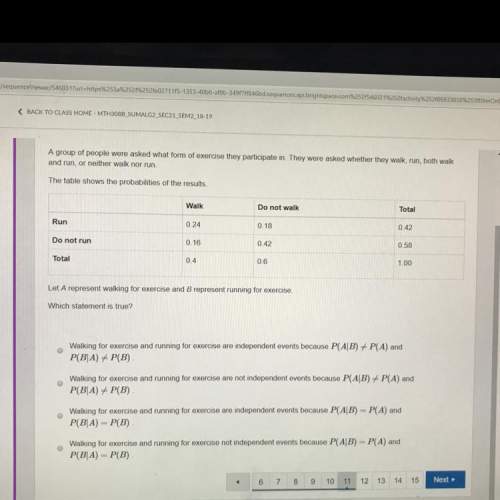What is the missing reason in steps 7 and 8 of the proof?
given: ∆abc with ab = c, bc = a, a...

Mathematics, 23.08.2019 05:00 erikloza12pdidtx
What is the missing reason in steps 7 and 8 of the proof?
given: ∆abc with ab = c, bc = a, ac = b
prove: = =
statement reason
1. draw a line through b that is perpendicular to and label the point of intersection with as d. construction
2. in ∆abd, bd = c sin a definition of sine in right triangle
3. in ∆cbd, bd = a sin c definition of sine in right triangle
4. c sin a = a sin c substitution property of equality
5. = dividing throughout by sin a
sin c
6. draw a line through a that is perpendicular to and label the point of intersection with as e. construction
7. in ∆bae, ae = c sin b
8. in ∆cae, ae = b sin c
9. c sin b = b sin c substitution property of equality
10. = dividing throughout by sin b
sin c
11. = = transitive property of equality
definition of cosine in right triangle
definition of sine in right triangle
definition of tangent in right triangle
corresponding sides of congruent triangles are equal.
definition of equilateral triangle

Answers: 2


Another question on Mathematics

Mathematics, 21.06.2019 16:30
Determine whether the quadrilateral below is a parallelogram. justify/explain your answer (this means back it up! give specific information that supports your decision. writing just "yes" or "no" will result in no credit.)
Answers: 2

Mathematics, 21.06.2019 17:00
Complete the equation of the line through (−10,3) and (−8,−8). use exact numbers.
Answers: 1

Mathematics, 21.06.2019 18:40
Juliana says that she can use the patterns of equivalent ratios in the multiplication table below to write an infinite number of ratios that are equivalent to 6: 10. which statement explains whether juliana is correct? she is correct because she can multiply 6 and 10 by any number to form an equivalent ratio. she is correct because 6: 10 can be written as 1: 2 and there are an infinite number of ratios for 1: 2. she is not correct because the multiplication table does not include multiples of 10. she is not correct because 6: 10 is equivalent to 3: 5 and there are only 9 ratios in the multiplication table that are equivalent to 3: 5.
Answers: 1

Mathematics, 21.06.2019 19:30
Ineed with angles and the measure of them i have abc a is 65 and b is (3x-10) and c is (2x) find the value of x
Answers: 2
You know the right answer?
Questions

Mathematics, 18.07.2019 11:30

Chemistry, 18.07.2019 11:30



Mathematics, 18.07.2019 11:30




Mathematics, 18.07.2019 11:30

Biology, 18.07.2019 11:30





Mathematics, 18.07.2019 11:30

Biology, 18.07.2019 11:30

Computers and Technology, 18.07.2019 11:30

Biology, 18.07.2019 11:30

Spanish, 18.07.2019 11:30




